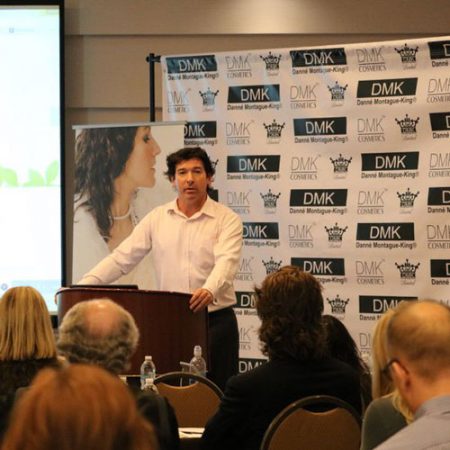DMK’s Daniel Dickson* explains why therapists are letting clients, themselves and a business down by not upselling skin treatments as a work in progress.
Correcting a problem skin condition or re-educating a client’s skin in a 12-week program can be truly life changing – and it’s the kind of result that will bring clients back repeatedly to a salon, spa or clinic.
However, many therapists struggle in prescribing treatment programs and will give feedback to the boss like: “My clients don’t like to do programs”; “My clients can’t afford that”; “They were just looking for a single treatment today”.
Perhaps they fear clients will see being offered programs as doing a hard sell to increase profits. I see it as the complete opposite. If a therapist is working regularly (say, once a week for 12 weeks) with a client, using targeted treatment formulations and home prescriptives, it is impossible not to achieve a result.
Often people will blame money as the primary reason for not engaging in treatment programs but, in my experience, there are so many more factors involved.
For instance, pricing only really becomes an “issue” when the client isn’t confident in either the business, the therapist or the treatment program, and so that business will struggle to attract repeat clientele.

Equally, there are many factors involved that allows clients to subconsciously decide that this therapist or that clinic is the right fit for them.
Until you have suffered a distressing skin condition, you will never truly understand hang-ups and other issues it causes people on a daily basis.
So, programs to me are more about building the client’s confidence: to know that the program that you’ll prescribe and guide them through will transform their skin; re-educating it and unlocking its genetic potential. Hence, giving them a skin they will love!
During programs, you can revise the texture of the skin, increase its vitality, normalise the cell proliferation and secretions, aid with repairing the bi-layers of the skin.
This in turn improves barrier function and assists the skin to retain free water levels, thus improving hydration.
These are all functions that we can achieve in skin revision to ensure that a client’s outcome is desirable and one that they feel they’ve received value from.
These are not simple tasks and are not achievable in one, or even two treatments. Or, for that matter, with one or two home prescriptive products.
As we go through our consultations and devise a treatment plans at DMK clinics, it includes educating the client about the home skin prescriptives being recommended for them, and why they are essential.
We are doing more than “selling” to the client – we are laying down a path to revise their major concerns that we know is achievable in either a 6, 8 or 12-week time frame.
Building confidence comes from using appropriate terminology without confusing your client, using analogies to help explain the process, and what they should expect.
I always suggest using the same descriptive words that the client uses when describing what they do like or their main concern.
Also, managing expectations is part of a therapist’s job. Always be honest and realistic about the results that can be achieved – and then if expectations are exceeded, all the better!
Some therapists try to “throw the encyclopaedia” at a client during the consultation hoping that this will gain a client’s trust and respect, but in fact this can have the opposite effect – the client simply doesn’t understand what they’re talking about.
I like a thorough consultation, but I like it also to have meaning and relevancy, by asking the client to have one major goal out of the treatment/consult today and several overarching goals for the treatment program.
I then ask them to point out any other secondary concerns that they have as, in my experience, once you revise the primary focus the sub-concern will move to the new primary concern.
It is very important that we work on growing the knowledge of the client and help them understand that the commitment isn’t simply parting with money – the true commitment is them preforming their daily home prescriptives routine, ensuring that they are diligent and committed to their treatment program timing and structure. This all comes from the consultation and outline.
I often say to therapists that if they know what treatments and home presciptives are going to revise, normalise, or reduce the presenting condition of a client and they do not do a treatment and prescription plan, I believe they are ripping clients off or giving them unrealistic expectations.
Treatment plans and programs do not need to be a hard sell. If skin revision is your trade and you are enthusiastic about it, this will shine through to clients.
But if you don’t have a genuine interest in changing people’s lives through unlocking their skin’s potential, and just provide treatments ad hoc, this will demonstrate a lack of commitment.
I’m not saying that every person who walks through the door requires a treatment program, but I am saying that until you ask them what their primary skin concern is and what sort of impact it is having on their life, you and the client could miss a life-changing opportunity.
I believe that every person is a skin revision program in waiting.
- Daniel Dickson is Managing Director of DMK Australia and New Zealand. DANNEMKING.COM.AU




